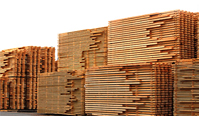Tuesday, June 16, 2015

Lower demand and a strengthening US dollar have sent lumber prices plummeting in the 1Q/15 to their lowest levels in more than two years in North America and Europe, reports the Wood Resource Quarterly. Import prices to Japan and China have followed a similar trend, although the decline has been less dramatic.
Seattle, USA.
Lumber prices have fallen throughout a majority of the main softwood
lumber markets in the world during the 1Q/15. The biggest declines have occurred in the US, Canada and the Nordic countries, while the drop in import prices to China and Japan has been more modest. Following is an excerpt from the Global Lumber Market Update
from the most recent issue of the Wood Resource Quarterly (www.woodprices.com):
North America
So far in 2015, the lumber market in the US has not improved as much as some market observers predicted (or hoped) last year. US housing starts during the four first months have ranged between 900,000 (February) and 1.13 million (April) starts on a seasonally adjusted annual rate. Despite housing starts being lower in the 1Q/15 than in the 4Q/14, lumber production in the US and Canada has increased slightly.
Lumber prices in the US have fallen substantially over the past nine months, with
southern yellow pine being down almost 30 percent, Douglas-fir declining 18 percent and spruce-pine-fir in Western Canada dropping 28 percent.
Northern Europe
Lumber prices in the Nordic countries have fallen substantially since last summer (in US dollar terms). The price declines in Finland and Sweden from August to February were 18 percent and 22 percent, respectively. Current price levels are the lowest since 2009 in both countries. The competitive prices in US dollar terms have resulted in a sharp increase in shipments from Sweden to the US, though these levels are still low. Finnish sawmills have shipped more lumber to China, Egypt, Saudi Arabia and the UK so far this year as compared to 2014.
Russia
With the decline in the value of the Rouble, Russian lumber has been become more
competitive over the past 15 months. In dollar terms, the fall in the Russian currency has been about 27 percent, and in Euro terms, just over eight percent. The average value of exported lumber from Russia has declined from $180/m3 in early 2014 to $130/m3 in March of 2015. However, Russian sawmills have been slow to take advantage of their country’s weak currency.
Japan
So far this year there have been only been price adjustments in lumber prices in Japan. Average prices for the domestic Sugi have declined slightly in US dollar terms but were unchanged in Yen terms. Of the imported species, European whitewoods and Canadian hemlock have decreased the most, each falling about five percent from January through May.
China
Demand for softwood lumber in China has increased swiftly this spring. In February, import volumes were down to 860,000 m3, a two-year low, but have since doubled to 1.7 million m3 in just two months. Average import prices have fallen this year, with April prices reaching their lowest level since late 2012. Russian lumber continues to be the lowcost supplier. Global lumber, sawlog and pulpwood market reporting is included in the 52 page quarterly publication Wood Resource Quarterly (WRQ). The report, which was established in 1988 and has subscribers in over 30 countries, tracks sawlog, pulpwood, lumber and pellet prices, trade and market developments in most key regions around the world.
Tags: global timber and wood products, market research